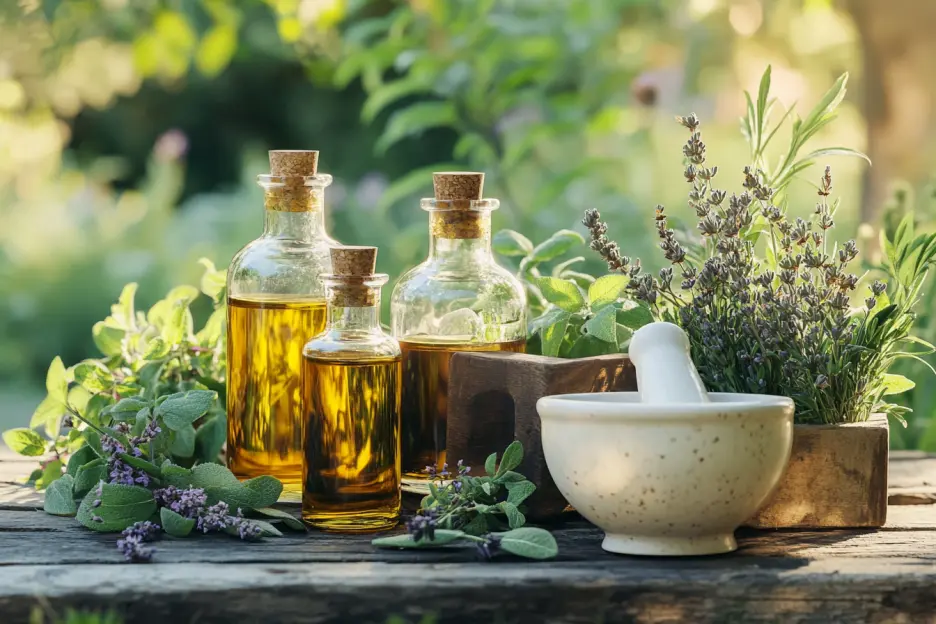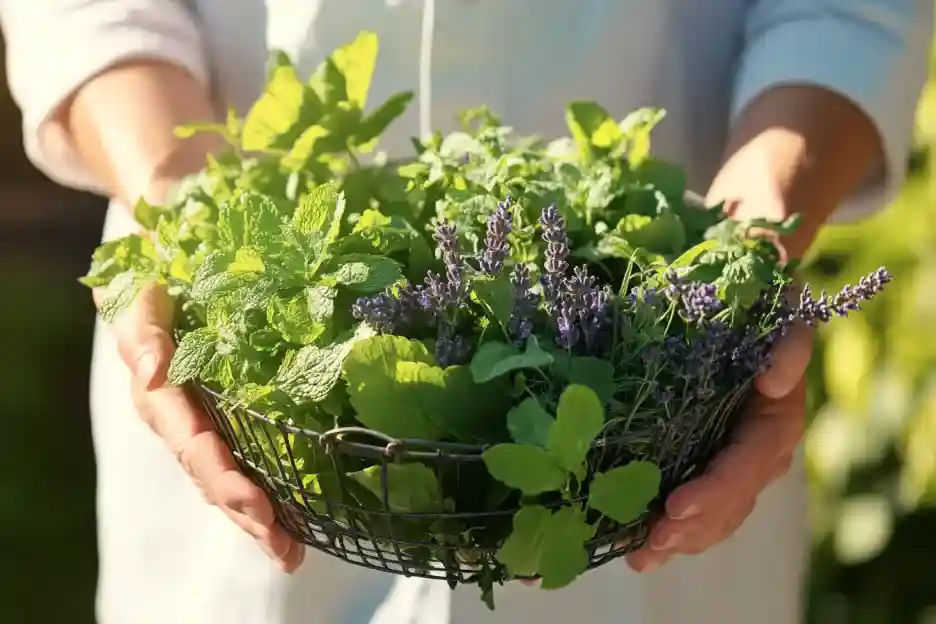Growing medicinal herbs in your garden is a rewarding and sustainable way to have natural remedies at your fingertips. These herbs not only support your health but also enhance the beauty and diversity of your garden. In this guide, we’ll explore the top 7 medicinal herbs that are easy to grow and offer numerous health benefits.

1. Peppermint (Mentha × piperita)
Growing Conditions
Peppermint thrives in partial shade to full sun and requires well-draining, moist soil. This fast-growing herb can spread quickly, so it’s best grown in containers or controlled spaces.
Medicinal Uses
Peppermint is well-known for its soothing effects on the digestive system, helping to relieve nausea, indigestion, and bloating. It’s also beneficial for headaches and respiratory issues due to its cooling menthol properties.
Harvesting Tips
Harvest peppermint leaves in the morning when the oils are most concentrated. Use fresh leaves for tea or dry them to make essential oils or tinctures.
2. Calendula (Calendula officinalis)
Growing Conditions
Calendula prefers full sun and well-drained soil. It’s a hardy plant that can tolerate cooler temperatures, making it ideal for many climates.
Medicinal Uses
Calendula is widely used for its skin-healing properties. It has anti-inflammatory and antiseptic benefits, making it perfect for treating cuts, scrapes, and rashes. It can also be used in teas to support digestion.
Harvesting Tips
Pick the bright yellow or orange flowers during peak bloom. Dry the petals to make salves, oils, or teas for topical or internal use.
3. Echinacea (Echinacea purpurea)
Growing Conditions
Echinacea thrives in full sun and well-drained soil. It’s drought-tolerant, making it a low-maintenance addition to your garden.
Medicinal Uses
Known for its immune-boosting properties, echinacea is often used to prevent and reduce the severity of colds and flu. It also has anti-inflammatory benefits.
Harvesting Tips
Harvest echinacea flowers when they are in full bloom. Both the roots and flowers can be used to make tinctures, teas, or supplements.
4. Chamomile (Matricaria chamomilla)
Growing Conditions
Chamomile grows best in well-draining soil and full sun but can tolerate partial shade. It can be grown in garden beds or containers, making it versatile for small spaces.
Medicinal Uses
Chamomile is famous for its calming effects. It’s often used as a sleep aid and for reducing anxiety. It also supports digestive health by relieving upset stomachs.
Harvesting Tips
Harvest chamomile flowers when they are fully open. Dry them in a cool, dark place to preserve their potency for teas and infusions.
5. Lemon Balm (Melissa officinalis)
Growing Conditions
Lemon balm grows well in both full sun and partial shade, preferring rich, well-drained soil. Like mint, it can spread quickly, so consider using containers for better control.
Medicinal Uses
Lemon balm is a calming herb, used to reduce stress and anxiety. It also has antiviral properties and can aid in digestion, making it a valuable herb for multiple uses.
Harvesting Tips
Harvest the leaves before the plant flowers for the best flavor. Fresh or dried leaves can be used in teas, tinctures, or culinary dishes.
For more details on growing herbs like mint, check out this guide.
6. Holy Basil (Ocimum sanctum)
Growing Conditions
Holy basil prefers a sunny spot with well-drained soil. This heat-loving plant grows best in warm climates, but it can also thrive indoors with plenty of light.
Medicinal Uses
Holy basil is an adaptogen, meaning it helps the body adapt to stress. It is also anti-inflammatory and is often used to boost immunity and support mental clarity.
Harvesting Tips
Harvest holy basil leaves regularly to encourage bushy growth. You can use the leaves fresh in teas or dry them for later use in remedies.
7. Sage (Salvia officinalis)
Growing Conditions
Sage thrives in full sun and well-drained soil. It’s drought-tolerant, making it an excellent choice for dry climates.
Medicinal Uses
Sage is known for its ability to support respiratory health, improve memory, and reduce inflammation. It’s also commonly used as a natural remedy for sore throats and digestive issues.
Harvesting Tips
Pick sage leaves before the plant flowers for the best potency. Dry the leaves to make teas, infusions, or even smudge sticks for spiritual cleansing.
8. How to Harvest and Store Medicinal Herbs
Harvesting Guidelines
When harvesting medicinal herbs, it’s important to do so at the right time to retain the highest levels of essential oils and potency. Generally, herbs should be harvested in the morning after the dew has dried and before the heat of the day.
Storing Herbs
After harvesting, herbs can be dried by hanging them in a cool, dark, and well-ventilated space. Once dried, store them in airtight containers in a dark cupboard to preserve their freshness and medicinal properties.

9. Creating Your Own Medicinal Herb Garden
Best Practices for Growing Medicinal Herbs Together
Many medicinal herbs grow well together in garden beds or containers. Herbs like mint and lemon balm can spread quickly, so consider keeping them in separate containers.
Container vs. In-ground Gardening
Growing medicinal herbs in containers allows for better control, especially for invasive species. In-ground gardening works well for larger plants like echinacea or sage but may require more space and maintenance.
Organic Pest Control
Herbs are naturally resistant to many pests, but organic solutions like neem oil or companion planting with pest-repellent plants can help keep your herb garden healthy.
For more tips on medicinal gardening, explore this comprehensive guide on growing herbs here.
Frequently Asked Questions (FAQs)
Q: How do I prevent my mint and lemon balm from taking over my garden?
A: Mint and lemon balm can spread quickly. Growing them in containers or using underground barriers in your garden will help control their spread.
Q: Can I grow medicinal herbs indoors?
A: Yes, many medicinal herbs, like mint, lemon balm, and holy basil, grow well indoors as long as they receive enough sunlight. Place them near a sunny window or use grow lights to ensure they thrive.
Q: When is the best time to harvest medicinal herbs?
A: The best time to harvest most herbs is in the morning, just after the dew has dried. This is when the plants’ essential oils are at their highest concentration, giving you the best flavor and potency.
Q: How should I store dried herbs to keep their medicinal properties intact?
A: Store dried herbs in airtight containers, away from sunlight and moisture, to preserve their potency. A cool, dark cupboard is an ideal storage space.
Q: Can I grow medicinal herbs in small spaces or containers?
A: Absolutely! Many medicinal herbs, such as peppermint, lemon balm, and calendula, grow well in containers. This method also helps control their spread and allows you to move them indoors during colder months.
Conclusion:
Growing medicinal herbs at home is a simple, sustainable way to enhance your health and well-being. By following these steps, you can create your own herbal garden filled with powerful, natural remedies. Whether you’re using peppermint for digestion or echinacea to boost your immune system, these herbs will enrich both your garden and your life.

